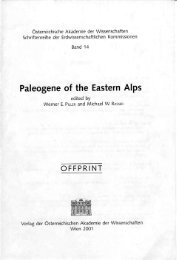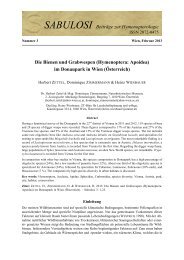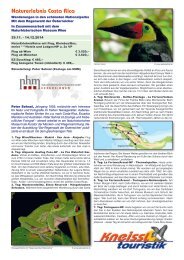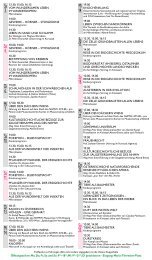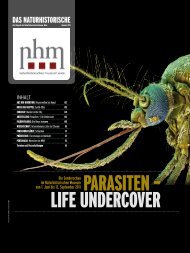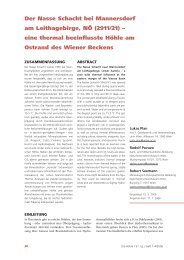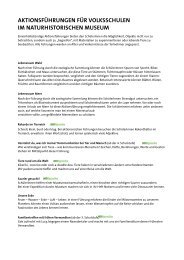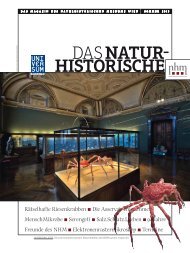The unknown brachypterous morph of Polhemovelia ZETTEL ...
The unknown brachypterous morph of Polhemovelia ZETTEL ...
The unknown brachypterous morph of Polhemovelia ZETTEL ...
Create successful ePaper yourself
Turn your PDF publications into a flip-book with our unique Google optimized e-Paper software.
Ann. Naturhist. Mus. Wien 109 B 83 - 86 Wien, März 2008<br />
<strong>The</strong> <strong>unknown</strong> <strong>brachypterous</strong> <strong>morph</strong> <strong>of</strong> <strong>Polhemovelia</strong><br />
<strong>ZETTEL</strong> & SEHNAL, 2000 (Insecta: Heteroptera: Veliidae)<br />
H. <strong>ZETTEL</strong> *<br />
Abstract<br />
<strong>The</strong> genus <strong>Polhemovelia</strong> <strong>ZETTEL</strong> & SEHNAL, 2000 is known from three species from Borneo. Hitherto only<br />
the macropterous <strong>morph</strong> was known. A <strong>brachypterous</strong> male <strong>of</strong> P. septuaginta <strong>ZETTEL</strong> & SEHNAL, 2000 is<br />
described.<br />
Key words: Heteroptera, Veliidae, <strong>Polhemovelia</strong> septuaginta, brachyptery, wing poly<strong>morph</strong>ism<br />
Zusammenfassung<br />
Die Gattung <strong>Polhemovelia</strong> <strong>ZETTEL</strong> & SEHNAL, 2000 umfasst drei Arten aus Borneo und war bisher nur in<br />
der makropteren Form bekannt. Ein brachypteres Männchen der Art P. septuaginta <strong>ZETTEL</strong> & SEHNAL, 2000<br />
wird beschrieben.<br />
Introduction, material and methods<br />
This short note reports on the finding <strong>of</strong> a short-winged male <strong>of</strong> <strong>Polhemovelia</strong> septuaginta<br />
<strong>ZETTEL</strong> & SEHNAL, 2000 in unsorted material <strong>of</strong> the collection in the Natural History<br />
Museum Vienna. When <strong>ZETTEL</strong> & SEHNAL (2000) described the genus <strong>Polhemovelia</strong><br />
from numerous macropterous individuals belonging to three species in Sabah,<br />
northern Borneo, this specimen was overlooked. Because <strong>brachypterous</strong> individuals are<br />
rare in Veliidae, and wing poly<strong>morph</strong>ism and wing autotomy <strong>of</strong>ten reflect phylogenetic<br />
relationships <strong>of</strong> higher taxa <strong>of</strong> Gerro<strong>morph</strong>a (see Discussion), this specimen is described<br />
and illustrated here.<br />
Terminology follows <strong>ZETTEL</strong> & SEHNAL (2000). <strong>The</strong> digital photograph was taken with<br />
a Leica DFC490 camera attached to a Leica MZ16 binocular microscope with the help<br />
<strong>of</strong> Image Manager IM50 and processed with Auto-Montage Pro and Adobe Photoshop<br />
7.0 programmes.<br />
<strong>Polhemovelia</strong> septuaginta <strong>ZETTEL</strong> & SEHNAL, 2000<br />
Material examined: One <strong>brachypterous</strong> male, labelled "MALAYSIA: Sabah\ Danum Valley, Water\ Pool,<br />
11.2.1997\ leg. H. Zettel (13)", in the Natural History Museum Vienna.<br />
* Dr. Herbert Zettel, International Research Institute <strong>of</strong> Entomology, Natural History Museum, Burgring<br />
7, A-1010 Vienna, Austria – herbert.zettel@nhm-wien.ac.at
84 Annalen des Naturhistorischen Museums in Wien 109 B<br />
Description <strong>of</strong> <strong>brachypterous</strong> <strong>morph</strong> (Fig. 1): Slightly smaller than macropterous<br />
males, body length 2.3 mm; head width 0.55 mm; pronotum width (= maximum body<br />
width) 0.81 mm. Colour, most structural characteristics, and genitalia (dissected) similar<br />
to those <strong>of</strong> macropterous males. Pronotum slightly smaller, ratio pronotum width :<br />
head width = 1.47 vs. 1.59 - 1.64, and with humeri slightly less developed than in<br />
macropterous males, but with similar ratio pronotum width : pronotum length (1.22 vs.<br />
1.22 - 1.27). Forewing distinctly shortened, posteriorly reaching base <strong>of</strong> tergite 7, and<br />
narrow, leaving approximately lateral half <strong>of</strong> lateraltergites 3 - 6 uncovered. Forewing<br />
cells similarly developed as in fully winged individuals, but proportionally smaller; and<br />
white spots on forewing similarly distributed, but those situated in the distal cells very<br />
small. Erect setae on forewings and also on head and pronotum reduced, but eventually<br />
rubbed <strong>of</strong>f during preparation.<br />
Discussion<br />
<strong>The</strong> adaptive significance <strong>of</strong> wing poly<strong>morph</strong>ism in Gerro<strong>morph</strong>a has been discussed<br />
and confirmed by many authors (earlier studies summarized in ANDERSEN 1982; for<br />
Gerridae see also ANDERSEN 1993, 2000), and in Gerridae flightless individuals are<br />
known in all genera (ANDERSEN 2000 and pers. observations). <strong>The</strong> modes <strong>of</strong> wing poly<strong>morph</strong>ism<br />
or di<strong>morph</strong>ism and the ability <strong>of</strong> wing autotomy at a certain position <strong>of</strong> the<br />
wing are important, group-specific characteristics (see e.g. ANDERSEN 1982: tab 15;<br />
2000). Interestingly, these features (and also characteristics related with wing poly<strong>morph</strong>ism<br />
like the design <strong>of</strong> thoracic nota) seem to be mostly evolutionarily old traits, and<br />
therefore they are useful for understanding the phylogenetic system <strong>of</strong> higher taxa (subfamilies,<br />
tribes, genera, subgenera, species groups) in Gerro<strong>morph</strong>a. Most Gerro<strong>morph</strong>a<br />
individuals are fully winged (macropterous) or wingless (apterous), while short-winged<br />
(micropterous, <strong>brachypterous</strong>) specimens are only known in six subfamilies: Hebridae:<br />
Hebrinae; Hydrometridae: Hydrometrinae; Veliidae: Ocelloveliinae, Microveliinae,<br />
Veliinae; Gerridae: Gerrinae (ANDERSEN 1982). In some <strong>of</strong> these groups, however,<br />
brachyptery is restricted to a small number <strong>of</strong> taxa; for example, in Velia only the<br />
nominotypical subgenus with the single species Velia rivulorum (FABRICIUS, 1775) has<br />
short-winged individuals. Wing autotomy in macropterous <strong>morph</strong>s is also group-specific:<br />
For example, in the subfamily Ptilomerinae <strong>of</strong> the Gerridae the wings are mutilated<br />
at the wing base, but in freshwater Halobatinae (Metrocorini) the wings are broken<br />
<strong>of</strong>f distal <strong>of</strong> the fore wing’s cells (at about apical third); in Rhagovelia (Veliidae:<br />
Rhagoveliinae) the ability to mutilate their wings, either at the base or at mid-length, is<br />
restricted to certain species groups (POLHEMUS & POLHEMUS 1988, NIESER & al. 1997,<br />
<strong>ZETTEL</strong> 2003); and the length <strong>of</strong> the wing pads or wing straps in flightless individuals is<br />
useful to define certain species groups <strong>of</strong> Hydrometra (Hydrometridae) (YANG &<br />
<strong>ZETTEL</strong> 2005). Most species <strong>of</strong> Microveliinae have a wing di<strong>morph</strong>ism with macropterous<br />
and apterous individuals, or only one <strong>of</strong> these two <strong>morph</strong>s is known (macroptery<br />
more common than aptery). A wing poly<strong>morph</strong>ism with more than two <strong>morph</strong>s is <strong>unknown</strong><br />
in Microveliinae, and a wing di<strong>morph</strong>ism with fully winged and short-winged<br />
specimens is rare: Micropterous individuals (with small wing pads) are known in<br />
Tarsovelia POLHEMUS & POLHEMUS, 1994 from New Guinea (POLHEMUS & POLHEMUS<br />
1994) and in a few species <strong>of</strong> the apparently not monophyletic genus Microvelia s.l., e.g.
<strong>ZETTEL</strong>: <strong>The</strong> <strong>brachypterous</strong> <strong>morph</strong> <strong>of</strong> <strong>Polhemovelia</strong> (Veliidae) 85<br />
Fig. 1: Brachypterous male <strong>of</strong> <strong>Polhemovelia</strong> septuaginta, dorsal aspect.<br />
in the Neotropical M. laesslei group and in M. karunaratnei POLHEMUS, 1999 from Sri<br />
Lanka (POLHEMUS 1999). <strong>The</strong> author has examined <strong>brachypterous</strong> individuals <strong>of</strong> an<br />
unidentified species <strong>of</strong> Tarsoveloides ANDERSEN & WEIR, 2001 from New Guinea (specimens<br />
in NHMW; unpublished), and now also a <strong>brachypterous</strong> male <strong>of</strong> <strong>Polhemovelia</strong>.<br />
As the phylogeny <strong>of</strong> Microveliinae is still very unclear, brachyptery (and wing autotomy,<br />
too) may also be a mosaic piece to improve our knowledge on the relationships<br />
<strong>of</strong> microveliine genera in the future.<br />
References<br />
ANDERSEN N.M., 1982: <strong>The</strong> semiaquatic bugs (Hemiptera, Gerro<strong>morph</strong>a). Phylogeny, adaptations,<br />
biogeography and classification. – Entomonograph 3, 455 pp.<br />
ANDERSEN N.M., 1993: <strong>The</strong> evolution <strong>of</strong> wing poly<strong>morph</strong>ism in water striders (Gerridae): a phylogenetic<br />
approach. – Oikos 67: 433-443.
86 Annalen des Naturhistorischen Museums in Wien 109 B<br />
ANDERSEN N.M., 2000: <strong>The</strong> evolution <strong>of</strong> dispersal di<strong>morph</strong>ism and other life history traits in water<br />
striders (Hemiptera: Gerridae). – Entomological Science 3(1): 187-199.<br />
NIESER N., <strong>ZETTEL</strong> H. & CHEN P.-P., 1997: Ten new species <strong>of</strong> Rhagovelia (Heteroptera: Veliidae)<br />
from Sulawesi (Indonesia). – Tijdschrift voor Entomologie 140: 17-41.<br />
POLHEMUS J.T., 1999: Two new species <strong>of</strong> Microvelia from treeholes, with notes on other container-inhabiting<br />
veliid species (Heteroptera: Veliidae). – Journal <strong>of</strong> the New York Entomological<br />
Society 107(1): 31-37.<br />
POLHEMUS J.T. & POLHEMUS D.A., 1988: Zoogeography, ecology, and systematics <strong>of</strong> the genus<br />
Rhagovelia MAYR (Heteroptera: Veliidae) in Borneo, Celebes, and the Moluccas. – Insecta<br />
Mundi 2(3-4): 161-230.<br />
POLHEMUS J.T. & POLHEMUS D.A., 1994: Four new genera <strong>of</strong> Microveliinae (Heteroptera) from<br />
New Guinea. – Tijdschrift voor Entomologie 137: 57-74.<br />
YANG C.M. & <strong>ZETTEL</strong> H., 2005: Guide to the aquatic Heteroptera <strong>of</strong> Singapore and Peninsular<br />
Malaysia: 5. Family Hydrometridae. – <strong>The</strong> Raffles Bulletin <strong>of</strong> Zoology 53(1): 79-97.<br />
<strong>ZETTEL</strong> H., 2003: Eine neue Rhagovelia (Heteroptera: Veliidae) mit "phoretischen Männchen"<br />
von der Insel Samar, Philippinen. – Linzer biologische Beiträge 35(2): 1141-1146.<br />
<strong>ZETTEL</strong> H. & SEHNAL C., 2000: Notes on the Veliidae (Heteroptera) <strong>of</strong> Borneo: 2. <strong>Polhemovelia</strong><br />
n.gen., with description <strong>of</strong> three new species. – Journal <strong>of</strong> the New York Entomological<br />
Society 107(2-3): 124-134.






